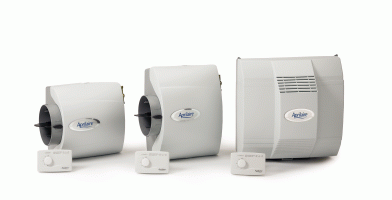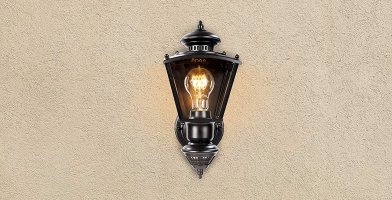Best Safety Vests Reviews & Ratings
Also known as reflective vests, safety vests enhance the reflectivity and visibility of personnel and allow easy detection by the public. Those working in construction, traffic control, security, or the fire department need to be easily identified to show who is in charge yet be safe. Even cyclists and runners use them to make motorists more aware of them, especially when visibility is poor. Safety vests are high on the list of PPE in many industries, and there are recognized safety standards for visibility and reflectivity. For this reason, most safety vests used in low visibility situations are either orange or yellow. To better understand what to consider when shopping for these valued items of PPE apparel, our buying guide can direct you to the best safety vests.
Our Top 3 Picks
[srpshortcode id=”15940″][/srpshortcode][srpshortcode id=”15941″][/srpshortcode][srpshortcode id=”15942″][/srpshortcode]
Governmental bodies have laid down requirements for safety vests, so selecting them in accordance with standards and directives will increase visibility and prevent employer fines for non-compliance. Finding the best safety vests and other PPE accessories such as jackets, gloves, hats, are essential for worker safety and comfort in dangerous situations. The ideal safety wear will also be comfortable and well-designed to meet the needs of workers with features such as pockets, easy accessibility, breakaway panels, and clips for attaching hardnesses and equipment.
6 Best Safety Vests
1. KwikSafety BIG KAHUNA
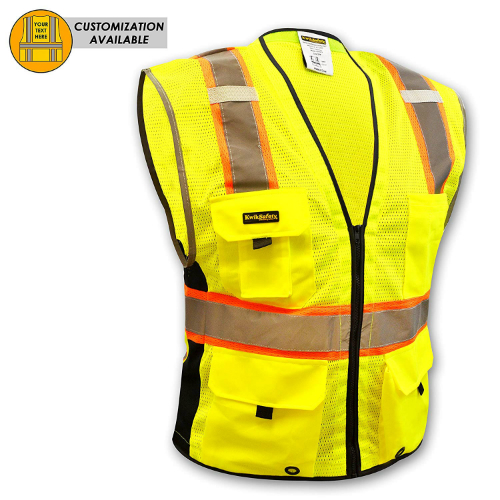
Design – First, there are three different tones made of breathable polyester for comfort even in scorching conditions. They are also available with silver reflective tape, which increases visibility when working at night. Black trimming gives the vest a clean finish. With this product, style meets functionality.
Multiple pockets – When working, there are tools and personal items that you need at hand. The Big Kahuna has two chest pockets to hold small equipment, two interior pockets for your wallet and phone, and two expandable cargo pockets with grommets for larger cargo.
This Class 2 vest is ANSI compliant. It is fashioned in polyester that is soft, reducing irritation and injuries. Also, the garment includes two heavy-duty zippers which can withstand abuse. Finally, you can customize the vests to bear your name and logo.
Product Features
100% polyester
Class 2 and ANSI compliant
Has six pockets
Comes in 3 different tones for various environments
Weight: 3.2 ounces
Who is it for?
First, being a class 2 vest, it can be used in high traffic areas with speeds of up to 25mph, e.g., road construction workers, and school crossing guards. Also, the silver reflective tape allows for use in areas with low visibility. Finally, the Orange or Yellow tones can be used by forest workers.
Different tones allow for usage in different contexts; it can be used in urban and rural settings while works flawlessly at night and during the day
Comfortable thanks to the polyester material used
Six different pockets for storing various items
Two durable zippers for closure
Customizable with your company name and logo
Some concerns about the stitching
2. Salzmann 3M
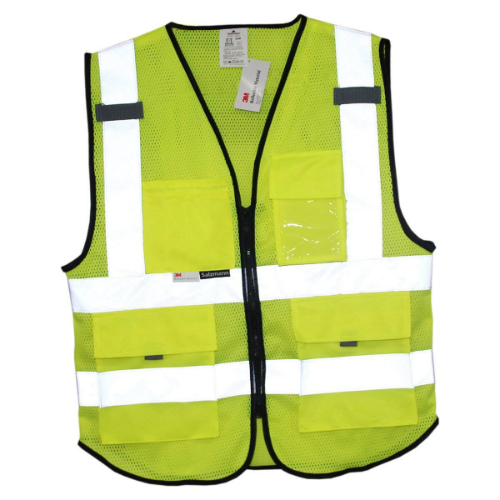
Radio clips – The Salzmann 3M has a pair of radio clips, one on each shoulder. Communication is vital in most construction projects, and getting the radio from your pocket frequently takes too long. The radio clips on this safety vest make communication more comfortable and faster.
Pockets – It has four pockets to keep small work equipment or cards, keys, etc.
This vest meets most ANSI requirements other than ANSI/ISEA 107-2015 section 10.5 that requires that it be fire retardant. There are also several variations, so you can be confident you will find one suitable for your environment. Finally, the reflective 3M tape allows you to use this item at night or in areas with limited light.
Product Features
Four pockets
Breathable fabric mesh
3M reflective tape
Who is it for?
With the 3M reflective tape, you can use the Salzmann to walk dogs in the evening or work at night or in areas with low visibility.
Radio clips on either shoulder make communicating a breeze
3M reflective tape keeps you safe when working at night
Affordable
There are some concerns about the size; ensure you use the updated size chart to get the right fit, or purchase one size larger
3. JKSafety 9
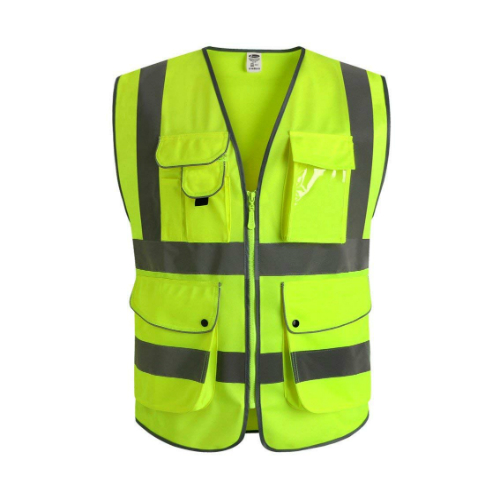
Multiple Pockets – This safety vest has nine pockets with numerous ways of organizing tools. There is a pocket for your smartphone, flashlight, pen, notebook, and even for business cards. The pockets increase the speed of accessing the tools, increasing efficiency. Also, to protect your devices, the pockets have zippers and velcro clamshell closure.
360® reflectivity – Other than the neon-yellow material which is highly visible, the J.K vest has 2-inch wide reflective strips on the chest, shoulders, waist, and back to ensure you are safe at all times, and from all directions. Working in low light conditions should not worry you with this vest.
This vest is that it is in total compliance with ANSI/ISEA class 2 requirements.
Product Features
360® reflectivity
Nine versatile pockets
100% polyester
Weight: 4.8 ounces
Who is it for?
Being a class 2 safety vest, you can use it in multiple environments where workers are exposed to speeds up to 25mph. Also, it’s ideal for persons in construction, demolition, surveyors, baggage handling, sanitation, etc.
Design of the vest allows for both day and night operations
Comfortable to use in hot conditions as it is lightweight and breathable
Multiple pockets increase personnel efficiency as all equipment is organized
There are some concerns with the quality as the stitching is a bit flimsy
4. GripGlo
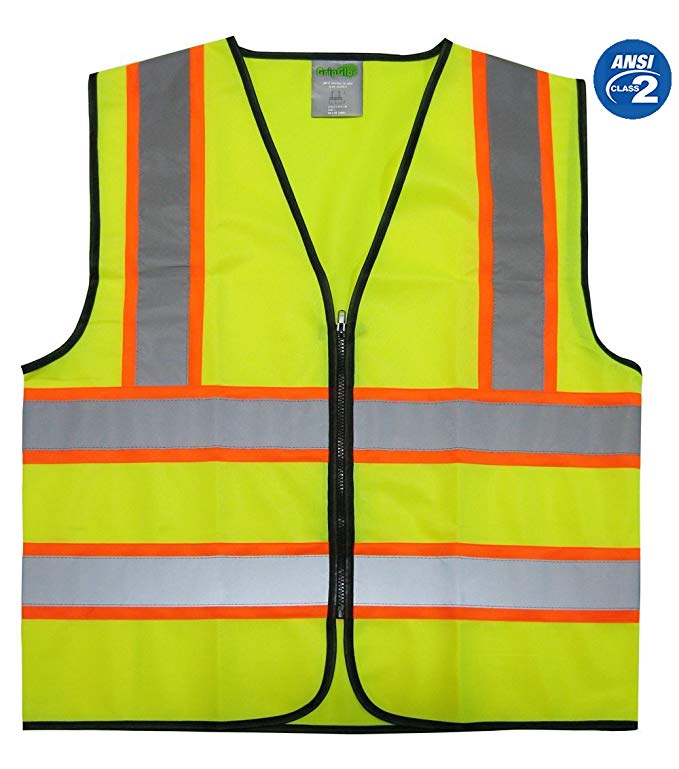
Contrast trimming – To increase the visibility of workers, joggers, and other personnel working in hazardous environments, the TLS-145 has contrast trimming to increase visibility by using an orange trim against the Neon Lime primary color of this vest.
360® reflectivity – Despite the visibility, reflectivity is essential when in low light conditions. The TLS-145 has reflective tape over the shoulders, around the waist and chest, and on the back to ensure motorists can spot you.
The vest is also compliant with ANSI/ISEA class 2 level 2 requirements. Finally, the easy on zipper closure makes wearing this a breeze.
Product Features
360® reflectivity
Contrast trimming for maximum visibility
Weight: 7.2 ounces
Who is it for?
We recommend the Griplo for class 1 environments. Despite being ANSI/ISEA Class 2 compliant, it lacks some other features (e.g., pockets) that are vital in these environments. But for jogging, riding, short-term construction projects or sanitation, it doesn’t get better than the TLS-145 by GripGlo.
Low-cost vest with premium features
360® reflectivity ensures you are visible in low-light conditions, and especially to motorists
Orrange contrast trimming increases visibility
Not a professional vest
5. Safety Depot Class 3 ANSI ISEA
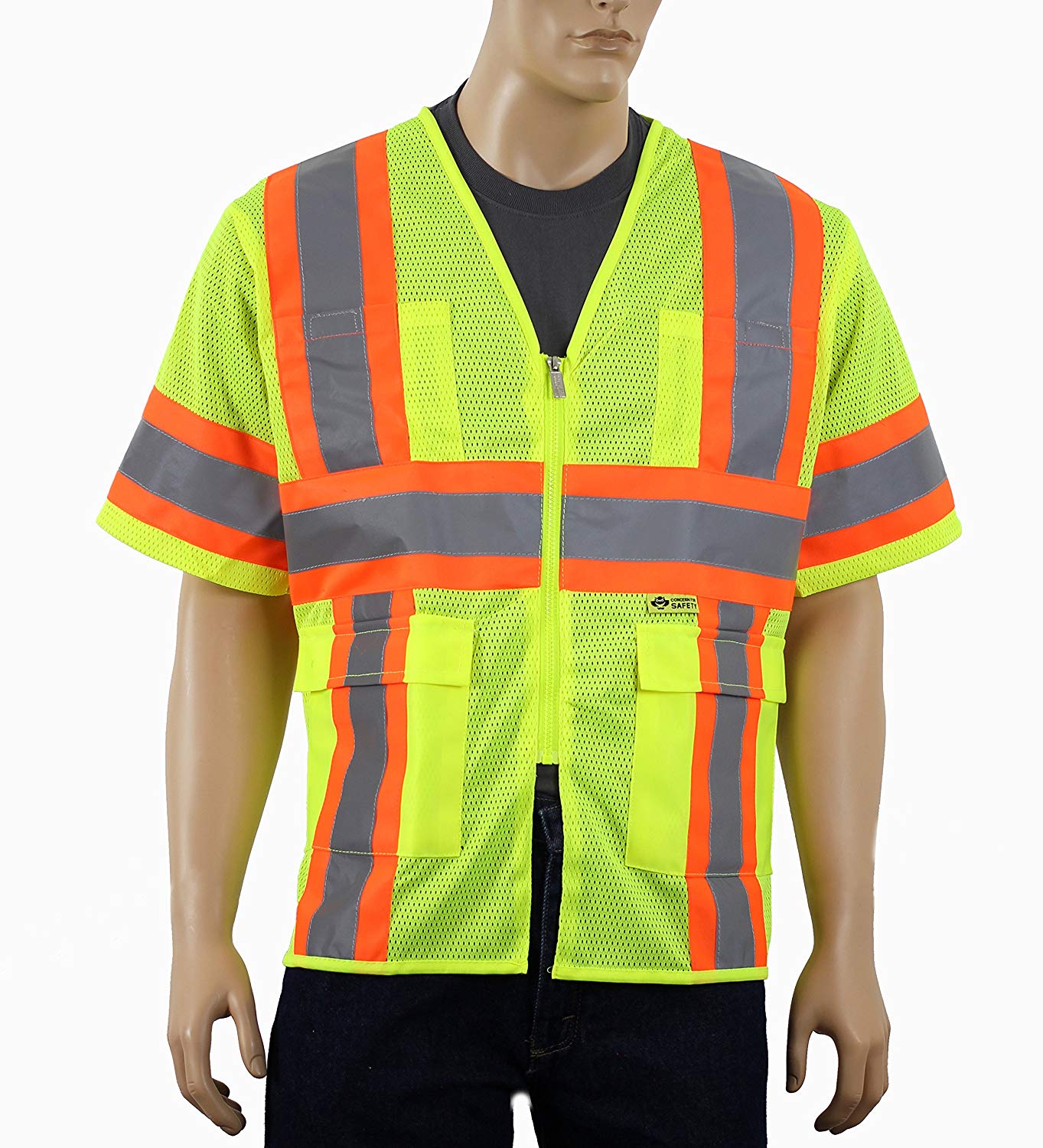
This vest has sleeves, so it fits more like a shirt. It and can withstand up to 25 washes in the washing machine.
Sleeves – The reason why most safety vests don't have sleeves is that they hinder movement. That is not the case for this option, which has arms large enough that they don't impede movement when you are working.
Pockets – The Safety Depot has six pockets for different purposes. The two chest pockets are for pens, pencils, voltage testers, etc., with a dedicated radio pocket. There are two other lower pockets have Velcro closures to secure your items.
This unit also includes a zipper for closure. The contrast trimming and the durability of this vest are outstanding. The garment has eight stitchings per inch to ensure that it can withstand abuse while working and washing. Also, it has an orange trimming against the primary neon-lime that increases the visibility. The reflective tape ensures that you can work in the wee hours of the morning and late into the night.
Product Features
Six pockets
Includes a zipper
Weight: 12.8 ounces
Who is it for?
This is a professional vest.
Despite being a class 3 vest, it is quite affordable
Durable with eight stitching per inch and can withstand up to 25 washings
Arms are massive and will not limit movement when working
Contrasting trim increases the visibility and as a result the safety of your workers
It is available in either solid polyester or breathable mesh
30-day satisfaction and quality guarantee
It is not an exact DOT3 vest; DOT3 vest has breakaway panels that allow you to escape if you are caught in something
6. Radians SV55-2ZGD
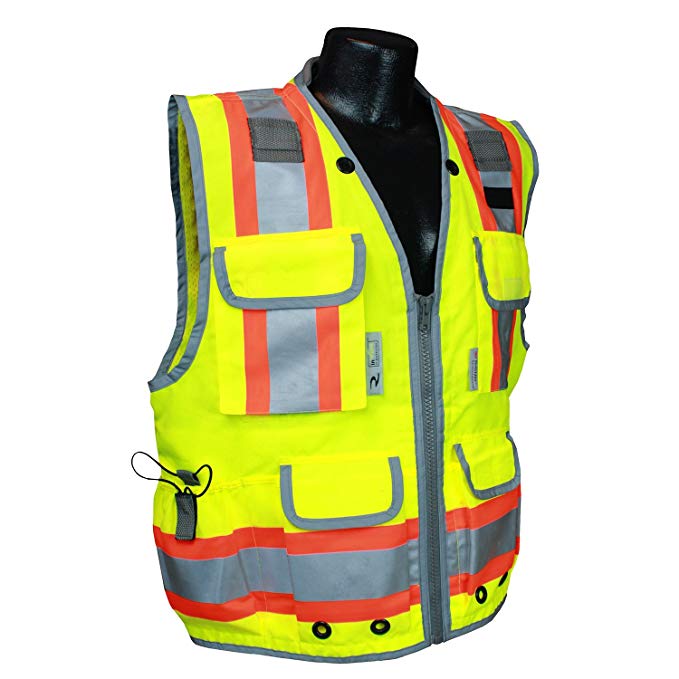
If you work on a construction site or an engineering project, you know that safety vests endure continuous wear and tear. Therefore, you should consider investing in a heavy-duty jacket, and the Radians SV55-2ZOD is one such vest. It is appealing for its two-tone design and its pockets.
Two-tone design – Most safety vests have a one-tone design with reflective tape for contrast. Though they do the job, they can't offer the same visibility as the two-tone design. The SV55-2ZOD has orange as its primary color with a 1-" Neon Yellow trimming between the vest and the reflective tape. This design increases the visibility and safety of workers.
Multiple Pockets – The six pockets on the SV55 have various uses. The chest pockets are designed to hold pens and flashlights, while the bottom pockets are for oversized items such as notebooks. However, the last two pockets are what's most exciting as they are designed to hold water bottles or paint cans.
The Radians SV55 is also lightweight at 8 ounces with a breathable polyester mesh on the back and is Class 2 ANSI compliant.
Product Features
Two-tone design with 1-inch contrast trimming
Heavy duty
360® reflectivity
Weight: 8 ounces
Who is it for?
Seeing as this is a heavy-duty Class 2 vest, we recommend it for persons in construction, demolition, or engineering projects where there is a higher likelihood of wear and tear. It can also work well for surveyors.
Vest can stand abuse
360® reflectivity will keep you safe even in low light conditions
Upper front pockets aren’t correctly configured to hold the items they are required to carry
What You Need to Know about Safety Vests
Safety vests are not just color-coordinated uniforms for parking attendants or camp counselors, so they are subject to safety criteria designated by OSHA (Occupation Safety and Health Administration) and the American National Standards Institute (ANSI). Depending on how dangerous your task is, your recommended safety vest may fall into one of three categories designated in the American National Standard for High-Visibility Safety Apparel and Accessories ANSI/ISEA 107-2015.
Compliant vests must be made of “conspicuous” materials which comply with certain standards for colors, background, retroreflectivity and combined-performance materials, and placement of materials. The standards apply to garments, supplemental items, and accessory items used to enhance the visibility and safety of workers.
While orange, yellow, or lime are the preferred colors, other colors may be worn in some circumstances when the lowest requirements for visibility are at a shorter distance. Reflective stripes should be around the middle in a 360º stripe and above each shoulder.
Based on the standards, which consider all occupational tasks, there are three types of safety vests covered by the standard: off-road (type O), roadway and temporary traffic control (type R), or public safety activities (type P).
Classifications
The vests are divided into three classes for materials and performance:
Class 1 Safety Vests are non-ANSI-approved vests used where traffic does not excel 25 mph. They are often worn by parking lot attendants, shopping cart retrievers, warehouse workers, parking attendants, delivery vehicle drivers, and anyone that needs high visibility recognition without meeting ANSI standards.
Class 2 Safety Vests are for workers with increased risk from traffic, especially during inclement weather. All workers within the public right-of-way of Federal Aid highway must wear ANSI-approved class 2 safety vests, including railway workers, school crossing guards, parking and toll gate personnel, airport ground crews, emergency response personnel, and law enforcement personnel directing traffic. The colors must be orange, yellow, or lime. The garment should clearly define the human form,
Class 3 Safety Vests have an even higher standard for workers in more dangerous conditions, such as roadway construction workers, utility workers, survey crews, demolition workers, and emergency service personnel. Visibility requirements are increased, and the garment should not be sleeveless. The reflective tape should be on arms and legs too.
Other Standards
Although the regulations appear straightforward, the requirements have escalated over the years, so PPE acquired to meet the past standards can only be used in certain circumstances. There are additional classifications to make things complicated.
Public Safety Vests, designed to meet ANSO 207-2006 standard, require a minimum background material of 450 sq. inches and a minimum reflective material of 201 sq. inches with a minimum width of 2″. They do not measure up to current Class 3 requirements for materials and reflectiveness. However, the FHWA approved revisions that allow law enforcement, emergency responders, and workers on Federal highways, although working toward compliance is the goal.
Type P Vests for Public Safety Use (Class 2 and 3) require extra reflective material and design to accommodate access to special equipment. They are meant for emergency and incident responders and law enforcement personnel who are exposed to hazards on roadways or off-road work environments.
FR Vests (Flame Resistant) & Self Extinguishing Vests are required for utility, welding, public safety, oil fields, first responders, petrochem refining, and shipyards workers who need protection from sparks, flames, and arc flashes.
Garments must also be appropriately labeled with the ANSI standard they are complying with.
Criteria For Selecting the Best Safety Vests
Proper Classification for the Task
OSHA has designated what type of safety vest is recommended for various tasks and operations. All vests except those to be used in low traffic areas must be ANSI-approved. When buying safety vests, the first thing to look for is that they meet all safety requirements for the type of work they are designated for and the conditions and time of day they will be used. The key to classification levels is “conspicuity” – how easily the wearer can be seen or noticed where they will be used at the time of day they will be used.
Buyers have to answer questions about whether the vests are for women, flaggers, night work, or traffic purposes. For flaggers, they must be visible from 1,000 feet away but have no other regulations as long as the material is retro-reflective. For nighttime operations, the primary criterion is that the visibility at night is equal to that of traffic vests during the day. This can be accomplished by having the whole vest made of reflective material, using highly reflective elements on the stripes, or using a lighted vest. Garments designed for women are cut differently, so they are comfortable and practical.
Task-Specific Needs
Safety Vests should accommodate special conditions associated with particular jobs. Occupations that need extra durability, protection from rain or extreme heat, extra visibility, or design features that include pockets, vents, and harness clips can find a vest just right for them.
For example:
- Water-related safety vests provide high visibility during water activities and may include some life-saving capabilities.
- Construction safety vests offer high visibility in areas where heavy machinery is used, even in inclement weather.
- Rainwear vests combat the drop in visibility when it’s raining and improve your reflectivity when riding on the highway.
- For air and sea operations or for those who face fall hazards, a safety harness vest allows attaching a harness.
- Surveyors might appreciate mesh vests for breathability and lots of pockets for phones, tools, and supplies.
- Night workers might need lighted vests or jackets with a light source such as an LED that makes it glow or light.
Materials
When purchasing a safety vest, there are three primary materials. The first is woven 100% polyester. However, if you are working in sweltering conditions, a polyester mesh safety vest will do as it is visible. Vinyl may also be used where permitted, but this should only be considered for the low cost.
The reflective materials in use generally fall into 2 categories – open-cell / glass bead or closed-cell / prismatic products. On garments, the open cell/ glass bead product such as 3M™ Scotchlite™ Materials is the most common. Glass bead is actually very small pieces of glass captured in an adhesive layer.
While cotton fabric can be used for non-compliant vests, it is not approved for ANSI 107-2010, which requires that background colors of lime or orange remain bright even after washing. Natural cotton fibers will often not hold the dye and will wash out. Even with the proper reflective tape, the resulting garments will not comply with the ANSI standard. Many polyester knit fabrics have a cottony feel, breathability, durability, and comfort.
Workers in some industries must wear Flame Resistant (FR) and Self-Extinguishing vests that meet ASTM 1506 standards.
Color
ANSI has approved 3 specific fluorescent colors for use – lime-yellow, orange, and red. The red is primarily a European offering, while in the United States, the lime-yellow and orange are available. Lime-yellow is the most frequently used, due to its better visibility, especially in a cluttered work zone where barricades and zones are often orange. Orange is also the color used by the prison system, so road crews do not want to be assumed to be penal work crews.
Non-ANSI-approved vests might be other colors.
FAQs
1. How can I tell if a vest meets the ANSI/ISEA standards?
First, any compliant vest that meets the above standards has to have a performance class and type label. Also, you can ask for the declaration of conformity, a document that all manufacturers are required to complete showing that the material has been tested and meet the standard’s requirements. Also, the declaration of conformity shows that the materials have been tested to the industry standards.
2. When should I wear a safety vest?
High-visibility garments reduce the likelihood of fatal accidents, so anyone who works near traffic or moving equipment is required by local, state, or federal law to wear one while working.
3. What other features are offered with safety vests?
While safety vests and other apparel increase visibility, they also have features that make them convenient while working and protective against other hazards such as fire and inclement weather.
4. What are the standards for reflectivity applicable to safety vests?
Class 1 vests should have a minimum of 155 square inches of reflective tape in of 2″ or feet of 1-3/8″ tape. Dimensions of the reflective tape can be either 2-inch tape (6.46 linear feet) or 1 3/8-inch tape (9.39 linear feet).
Class 2 Vests have a minimum background fabric of 775 sq. inches and a minimum reflective material of 201 sq inches with a minimum width of 35mm around the middle and over the shoulder. (Reflective tape dimensions – 8.373 linear feet of 2″ tape or 12.2 linear feet of 1 3/8″ tape.)
Class 3 vests require a minimum background material of 1240 sq. inches and a minimum reflective tape of 310 sq. inches with a minimum width of 2″ or 50 mm and 12.92 linear feet.
5. How can I tell if a garment is flame resistant?
Safety vests must meet standards set by the National Fire Protection Association (NFPA) or the American Society for Testing and Materials (ASTM) for flame resistance. The ANSI/ISEA label shows the flame resistance of the vest, as determined by their testing. If the ANSI label doesn’t indicate flame resistance, check for a separate NFPA 1977 or 2112 label as these require an independent tag.
6. When should safety vests be replaced?
Quality reflective jackets are designed to serve you for a long time and should go through several washings without wearing down. However, the garments should be replaced whenever they become less efficient or the reflective bands lose their reflectivity.
Conclusion
High visibility vests are a requirement in any industry where there is the need to be seen to avoid danger. Our buying guide provides shopping tips to procure the best safety vests for your workforce.


